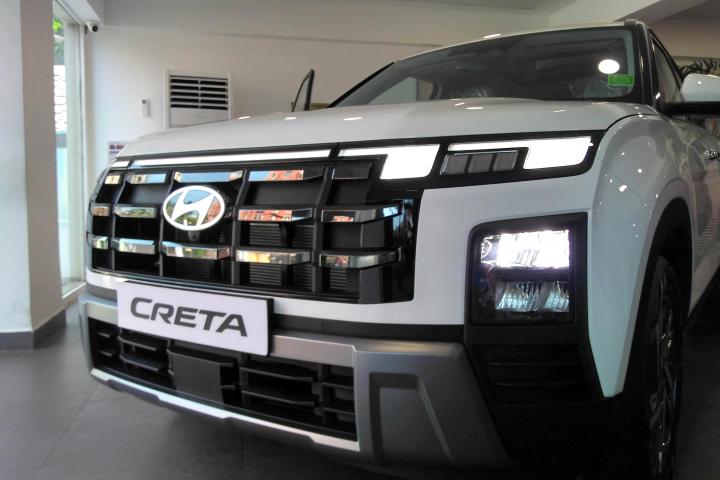News
First-gen Creta owner's honest thoughts about the 2024 Creta facelift
Hyundai got inspired by Mercedes Benz's wide dashboard displays. The driver's information display (MID) is obviously from the Alcazar.
BHPian Chhanda Das recently shared this with other enthusiasts.
1st generation pre-facelifted Creta owner checks out the 2nd generation facelifted Creta
As most of you may know, Hyundai India launched the long-awaited facelifted 2nd generation Creta in India on the 16th of January 2024 and you surely have seen more than enough reviews of it. However, I had the good fortune of checking it out from close quarters only recently and here are my thoughts on the subject. Better late than never, right?
Aesthetics
From the front, it seems to me that Hyundai was inspired by the Hummer EV (DRLs) while the headlights seem to be lifted almost exactly from the Hyundai Palisade. Overall, I find the facelifted 2nd gen Creta's front to be quite attractive.
From the sides, it seems to have a neutral typical SUVish look and there isn't much to talk about here. Thankfully, they didn't go for the 18-inch rims like those of its sibling Seltos which would have been overkill for our Indian road conditions for a car of this size.
From the rear, it appears to me as if Hyundai got really inspired by the Suzuki Ignis' tail lights and again by the Hummer EV's DRLs when it came to the tail lights which was also replicated in the Venue. I have mixed feelings about this. However, I am absolutely not a fan of the running brake light assembly on the entire width of the rear boot door/lid and it looks particularly horrendous on a white Creta, especially during the day. Overall, the rear of the facelifted 2nd generation Creta does not appeal to me.
Interiors
On the inside, Hyundai obviously got inspired by Mercedes Benz's wide dashboard displays. The driver's information display (MID) in the Creta now is obviously from the Alcazar. Hyundai seems to have cleverly placed a black filter on the dashboard to make it appear as if the infotainment system and the MID are one continuous unit. Overall, it seems quite appealing even though I like manual gauges more than the digital ones. I was pleasantly surprised by the fact that the steering wheel of the Creta is now adjustable for both reach and rake.
I find the dual-zone climate control to be quite useful especially since the average male and female human body temperatures are quite different. However, I was severely disappointed by the aesthetics of the AC control panel which seems quite tacky and appears as if they were taken from a car around 10-15 years ago.
They seem to have done a really good job with the implementation of the ADAS Level 2 functions exactly as I first recall seeing in the Palisade.
It is good to see dull and dark-coloured surfaces on top of the dashboard which would minimize the chances of reflections on the windshield for the driver.
Although Hyundai claims to have increased the use of high-strength steel along with further structural additions and enhancements in the facelifted 2nd generation Creta in India, it remains to be seen how the car performs in crash tests.
Cons
- I would have liked the placement of the ADAS radar at the front to be a bit recessed. Small running animals like cats, dogs, etc and sudden braking of the car along with flying stones from trucks ahead of us are not uncommon on our unpredictable highways. Any impact (even if slight) will damage that radar resulting in expensive repairs.
- The front grille and air dam area have gaps that are large enough for my hand to go in which makes the radiator susceptible to damage from flying stones and other hard debris especially at highway speeds apart from being another point of entry to the engine bay area for rodents. Hyundai could have easily added a honeycomb-like mesh grille like they did in the first-generation Creta.
- They are still continuing with the D-cut steering wheel instead of a circular steering wheel. D-cut steering wheels make complete sense in Formula (F) 1 racing cars which have limited space for the driver's ingress/egress and those steering wheels are completely removable with a single pull as well. Additionally, F1 cars can be turned completely in way less than a single complete turn of the steering wheel. However, a D-cut steering wheel is a safety hazard in a consumer car which needs a few turns of the steering wheel to completely turn the car. Moreover, a consumer car like a Creta does not have the space constraints that would necessitate a D-cut steering wheel.
- Uncovered storage spaces on the dashboard are a safety hazard in case of an unfortunate accident.
- The horizontal shape of the AC air vents means that they won't be able to cover a large part of your body directly which is a problem if you want to use the blower more instead of the AC especially in terms of fuel efficiency.
- The rear middle passenger seat does not have a headrest in the new facelifted Creta 2024. A headrest is very essential for reducing whiplash injuries to the neck. Even my 2017 Creta has this headrest.
- The uncovered Type-C charging ports at the rear are nearly upward facing which makes them very susceptible to dirt and debris ingress. Additionally, there is also the risk of damage from liquid spillages. Water/Juice consumption by rear passengers is not uncommon. And sometimes babies and children do throw up in the car too.
- Hyundai seems to have reduced the amount of plastic cladding in the spare wheel area which means that there will be increased heat ingress into the cabin from the exhaust system resulting in reduced fuel efficiency due to an increased load on the air conditioning system especially in our blistering Indian summers.
- I may be nitpicking here but the tools seem to be in a bag/pouch instead of a properly contoured receptacle area and hence they can rattle on bad roads leading to increased noise, vibrations and harshness (NVH) levels/
- I cannot recommend the uncommon colours of the newly launched Creta because matching the colours after repainting can be really excruciating once the car gets the inevitable scratches.
- I am not too fond of the newly launched 1.5 T-GDi Creta with DCT. Historically, DCTs have never been a reliable transmission over the long term irrespective of the manufacturer. Similarly, GDi engines too have faced reliability issues as early as 5-7 years irrespective of the manufacturer including two-wheeler ones. Add a turbocharger into the mix and we have a potent mixture for higher rates of engine failure due to the high amounts of pressures involved which are dangerously close to diesel territory. Additionally, this engine-transmission combination has not existed in the market for around 3 years which is like the proverbial golden period for cars to exhibit most of their underlying faults.
I believe that our official Team Bhp review has covered the overwhelming majority of all the other aspects very well and I don't think that I have much to add there.
Disclaimer
These are just my personal opinions and may or may not reflect the opinions of my fellow members here. I know this is late and I sincerely apologize for the delay but sadly, I got stuck with some personal work and I could not pay much attention here.
This is all that I can think of right now but I will add more to the list above later if I can remember/notice them. Wishing you all happy and safe drives ahead.
Check out BHPian comments for more insights and information.



















